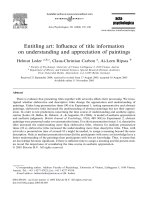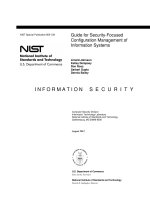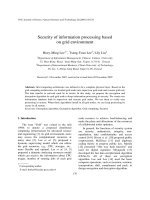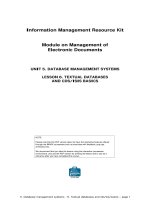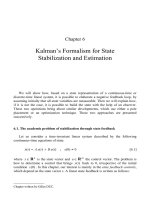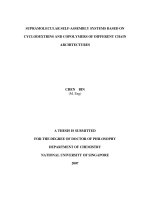lecture on safety and security of information systems lesson 6 7548
Bạn đang xem bản rút gọn của tài liệu. Xem và tải ngay bản đầy đủ của tài liệu tại đây (575.68 KB, 23 trang )
ASYMMETRIC CIPHERS
Contents
1)
Principles Of Public-Key Cryptosystems
2)
RSA Algorithm
1. Principles Of Public-Key Cryptosystems
1. Principles Of Public-Key Cryptosystems
Commonly know as public key cryptography
Invented by Whitfield Diffie and Martin Hellman in 1976
Uses a pair of key
A private key that is kept secret
A public key that can be sent to anyone
Public-Key Cryptosystems
Asymmetric algorithms rely on one key for encryption and a different but
related key for decryption. These algorithms have the following important
characteristic.
It is computationally infeasible to determine the decryption key given only
knowledge of the cryptographic algorithm and the encryption key.
Either of the two related keys can be used for encryption, with the other used
for decryption.
Encryption with public key
Encryption with private key
Authentication and confidentiality
possible to provide both the authentication function and confidentiality by
a double use of the public-key.
Z=E(PUb,E(PRa,X))
X=D(PUa,D(PRb,Z))
Applications for Public-Key Cryptosystems
Encryption/decryption: The sender encrypts a message with the
recipient’s public key.
Digital signature: The sender “signs” a message with its private key.
Key exchange: Two sides cooperate to exchange a session key.
Requirements for Public-Key Cryptography
It is computationally easy for a party B to generate a pair.
It is computationally easy for a sender A, knowing the public key and the
message to be encrypted,M, to generate the corresponding ciphertext.
C=E(PUb,M)
It is computationally easy for the receiver B to decrypt the resulting
ciphertext using the private key to recover the original message:
Requirements for Public-Key Cryptography
It is computationally infeasible for an adversary, knowing the public
key,PUb,to determine the private key,PRb.
It is computationally infeasible for an adversary, knowing the public key,
PUb, and a ciphertext, C, to recover the original message, M.
2. RSA ALGORITHM
RSA Algorithm
Developed in 1977 by Ron Rivest, Adi Shamir, and Len Adleman.
The RSA scheme is a block cipher in which the plaintext and ciphertext
are integers between 0 and n-1 for some n. A typical size for n is 1024 bits,
or 309 decimal digits. That is, n is less than 21024
Based on exponentiation in a finite field over intergers modulo a prime
Description of the Algorithm
Select two large prime numbers: p and q
Calculate: n = pq
Calculate: m=(p-1)(q-1)
Choose a small number e, co prime to m, with GCD(m,e)=1; 1
PU = (n, e), PR = (n, d)
Description of the Algorithm
Encryption:
C = Me mod n (với M < n)
Decryption:
M = Cd mod N
Euclid’s algorithm
Computing the greatest common divisor (GCD) of two numbers,
gcd(a,b) = gcd(b, a mod b)
1. A ← a; B ← b
2. if B = 0 return A = gcd(a, b)
3. R = A mod B
4. A ← B
5. B ← R
6. goto 2
Extended Euclid’s algorithm
1.
(A1, A2, A3) ← (1, 0, m); (B1, B2, B3) ← (0, 1, b)
2.
if B3 = 0 return A3 = gcd(m, b); no inverse
3.
if B3 = 1 return B3 = gcd(m, b); B2
4.
Q = A3 div B3
5.
(T1, T2, T3) ←(A1 – Q*B1, A2 – Q*B2, A3 – Q*B3)
6.
(A1, A2, A3) ← (B1, B2, B3)
7.
(B1, B2, B3) ← (T1, T2, T3)
8.
goto 2
Extended Euclid’s algorithm - example
Finding inverse of 7 in modulo 187
=>Result: 80
RSA Example
p = 11, q = 3 => n = pq=33
m= (p-1)(q-1) = (11 – 1)(3 – 1) = 20
Gcd(m,e)=1
e corprime to m, means that the largest numbet that can be exactly divide
both e and m (their greatest common divisor, or gcd) is 1. Euclid's
algorithm is used to find the GCD of two numbers
RSA Example
e=2 => GCD(20,e) = 2 (no)
e=3 => GCD(20,e)=1 (yes!)
Find d: using Extended Euclid's algorithm ? d=7
PU (33, 3), PR = (33, 7)
Plaintext: M = 15:
Encryption: C = 153mod 33 = 9
Deencryption: c=9
M = 97mod 33 = 15
RSA Security
Brute-force attack
Mathematical attack
Timing attack
Chosen ciphertext attack

